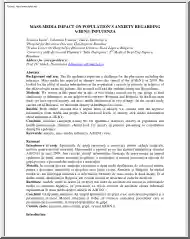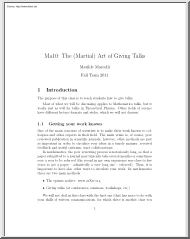No comments yet. You can be the first!
What did others read after this?
Content extract
ABC NEWS/WASHINGTON POST POLL: CHRISTMAS TREES – 12/19/04 EMBARGOED FOR RELEASE AFTER 5 p.m Thursday, Dec 23, 2004 Artificial Christmas Trees: A Growing Yuletide Trend You can deck the halls with holly, but the tree, these days, is likely to be made of plastic. Among Americans who put up a Christmas tree, a majority – 58 percent in the latest ABC News/Washington Post poll – say they use an artificial tree rather than a real one. That’s a sharp increase from 40 percent in a Gallup poll 15 years ago. Growers have noticed: The National Christmas Tree Association is running a game called “Attack of the Mutant Artificial Trees” on its website, with instructions that say, “The artificial trees have mutated and are sucking the spirit out of Christmas. Help the elf beat these bad guys by hitting them with snow balls!” 80% Christmas Trees: Real vs. Artificial Among People Who Put Up a Tree ABC News/Washington Post and Gallup polls 70% Now 1989 60% 58% 52% 50% 40% 40%
37% 30% 20% 10% 0% Real tree Artificial tree It may not be that easy. This poll finds majorities across population groups using artificial trees, ranging by age from 70 percent of seniors to 57 percent of 20-somethings, and including six in 10 Democrats and Republicans alike (finally, something they agree on). Recent reports cite a 34 percent drop in live-tree sales the past decade, and a 30 percent rise last year alone in the sale of fake trees, to 9.6 million The tree association argues that real trees offer fragrance, freshness and “the look and feel of the holidays,” and are a recyclable, renewable resource. Artificial trees, mainly manufactured in China, are promoted as being convenient (no needles on the rug, and some come with lights already hung), reusable and better quality than the old stick-figure stereotypes. Backers note that some buildings bar live trees out of fire-safety concerns The tree association reports an average price last year of $33.80 for a live
tree, compared with $68.80 for an artificial one Then again, the cost of a fake tree can be amortized; some even come with a 10-year warranty. There are differences among groups in the choice of real vs artificial trees. Income is one dividing line: Better-off people are more apt to buy live trees (but still, just 50 percent of those with household incomes over $75,000), while less well-off Americans are more apt to buy artificial trees (peaking at 66 percent of those in under-$20,000 households.) In a related result, people with post-graduate degrees are less likely to use artificial trees (these tend to be better-off Americans, and, who knows, may have taken esthetics in college). Use of artificial trees peaks in the South and Midwest, at 68 percent apiece, dropping sharply to 44 percent in the Northeast and 40 percent in the West. Similarly, 68 percent use fake trees in the “red” states (largely Southern and Midwestern) won by George W. Bush in the November election, compared
with 46 percent in the Kerry “blue” states. In follow-up interviews, respondents to this survey expressed mixed emotions about their choice of tree. Ida, in Florida, got her artificial tree on sale last year "Its beautiful, but I like the smell of a real tree,” she said. “I doubt Ill use the fake one again next year" In New Jersey, David Frank went artificial "because I got tired of putting a tree on top of my car and dragging it back and forth and then throwing it out after. Just laziness, thats all. No special reason I think about getting a real tree every now and then but before you know it the fake one comes out again. Its just more convenient” "When the kids were little we always went out and cut our own tree,” said Angela, in Pennsylvania. “But now theyre all grown up so we put it up when everybodys home around Thanksgiving and a real tree wouldnt make it. I love the real one though" Finally, on the side of convenience, "I moved from a
large house to a small apartment so I got a half tree that you can hang on the wall,” said Joan, in Michigan. “It was a space issue. Theyre great You can fold them up" These results, naturally, are limited to Americans who celebrate Christmas (94 percent of the public) and who usually put up a Christmas tree at home. That’s 88 percent of Christmas celebrants, or a net of 83 percent of all Americans. METHODOLOGY – This ABC News/Washington Post poll was conducted by telephone Dec. 16-19, 2004, among a random national sample of 1,004 adults The results have a three-point error margin. Sampling, data collection and tabulation by TNS of Horsham, Pa. Analysis by Gary Langer. ABC News polls can be found at ABCNEWS.com at http://abcnewscom/pollvaulthtml Media contact: Cathie Levine, (212) 456-4934, or Lisa Finkel, (212) 456-6190. Full results follow (*= less than 0.5 percent) 33. Do you celebrate Christmas, or not? 12/19/04 12/14/03* 12/4/00 12/18/94 *12/14/03 and Yes No No
94 6 95 5 96 4 96 4 previous: Gallup, opin. * * * * "Do you celebrate Christmas?" 34. (IF YES) Do you usually put up a Christmas tree in your home, or not? Yes No Sometimes (vol.) No opin. 12/19/04 88 10 1 * 10/15/89* 90 8 2 * *Gallup, "Do you usually put up a Christmas tree in your home?" 35. (IF YES) Is it (the Christmas tree you put up) usually a real Christmas tree or an artificial tree? 12/19/04 10/15/89* *Gallup. *END Real 37 52 Artificial 58 40 Both/It varies (vol.) 5 8 No opinion * *
37% 30% 20% 10% 0% Real tree Artificial tree It may not be that easy. This poll finds majorities across population groups using artificial trees, ranging by age from 70 percent of seniors to 57 percent of 20-somethings, and including six in 10 Democrats and Republicans alike (finally, something they agree on). Recent reports cite a 34 percent drop in live-tree sales the past decade, and a 30 percent rise last year alone in the sale of fake trees, to 9.6 million The tree association argues that real trees offer fragrance, freshness and “the look and feel of the holidays,” and are a recyclable, renewable resource. Artificial trees, mainly manufactured in China, are promoted as being convenient (no needles on the rug, and some come with lights already hung), reusable and better quality than the old stick-figure stereotypes. Backers note that some buildings bar live trees out of fire-safety concerns The tree association reports an average price last year of $33.80 for a live
tree, compared with $68.80 for an artificial one Then again, the cost of a fake tree can be amortized; some even come with a 10-year warranty. There are differences among groups in the choice of real vs artificial trees. Income is one dividing line: Better-off people are more apt to buy live trees (but still, just 50 percent of those with household incomes over $75,000), while less well-off Americans are more apt to buy artificial trees (peaking at 66 percent of those in under-$20,000 households.) In a related result, people with post-graduate degrees are less likely to use artificial trees (these tend to be better-off Americans, and, who knows, may have taken esthetics in college). Use of artificial trees peaks in the South and Midwest, at 68 percent apiece, dropping sharply to 44 percent in the Northeast and 40 percent in the West. Similarly, 68 percent use fake trees in the “red” states (largely Southern and Midwestern) won by George W. Bush in the November election, compared
with 46 percent in the Kerry “blue” states. In follow-up interviews, respondents to this survey expressed mixed emotions about their choice of tree. Ida, in Florida, got her artificial tree on sale last year "Its beautiful, but I like the smell of a real tree,” she said. “I doubt Ill use the fake one again next year" In New Jersey, David Frank went artificial "because I got tired of putting a tree on top of my car and dragging it back and forth and then throwing it out after. Just laziness, thats all. No special reason I think about getting a real tree every now and then but before you know it the fake one comes out again. Its just more convenient” "When the kids were little we always went out and cut our own tree,” said Angela, in Pennsylvania. “But now theyre all grown up so we put it up when everybodys home around Thanksgiving and a real tree wouldnt make it. I love the real one though" Finally, on the side of convenience, "I moved from a
large house to a small apartment so I got a half tree that you can hang on the wall,” said Joan, in Michigan. “It was a space issue. Theyre great You can fold them up" These results, naturally, are limited to Americans who celebrate Christmas (94 percent of the public) and who usually put up a Christmas tree at home. That’s 88 percent of Christmas celebrants, or a net of 83 percent of all Americans. METHODOLOGY – This ABC News/Washington Post poll was conducted by telephone Dec. 16-19, 2004, among a random national sample of 1,004 adults The results have a three-point error margin. Sampling, data collection and tabulation by TNS of Horsham, Pa. Analysis by Gary Langer. ABC News polls can be found at ABCNEWS.com at http://abcnewscom/pollvaulthtml Media contact: Cathie Levine, (212) 456-4934, or Lisa Finkel, (212) 456-6190. Full results follow (*= less than 0.5 percent) 33. Do you celebrate Christmas, or not? 12/19/04 12/14/03* 12/4/00 12/18/94 *12/14/03 and Yes No No
94 6 95 5 96 4 96 4 previous: Gallup, opin. * * * * "Do you celebrate Christmas?" 34. (IF YES) Do you usually put up a Christmas tree in your home, or not? Yes No Sometimes (vol.) No opin. 12/19/04 88 10 1 * 10/15/89* 90 8 2 * *Gallup, "Do you usually put up a Christmas tree in your home?" 35. (IF YES) Is it (the Christmas tree you put up) usually a real Christmas tree or an artificial tree? 12/19/04 10/15/89* *Gallup. *END Real 37 52 Artificial 58 40 Both/It varies (vol.) 5 8 No opinion * *




